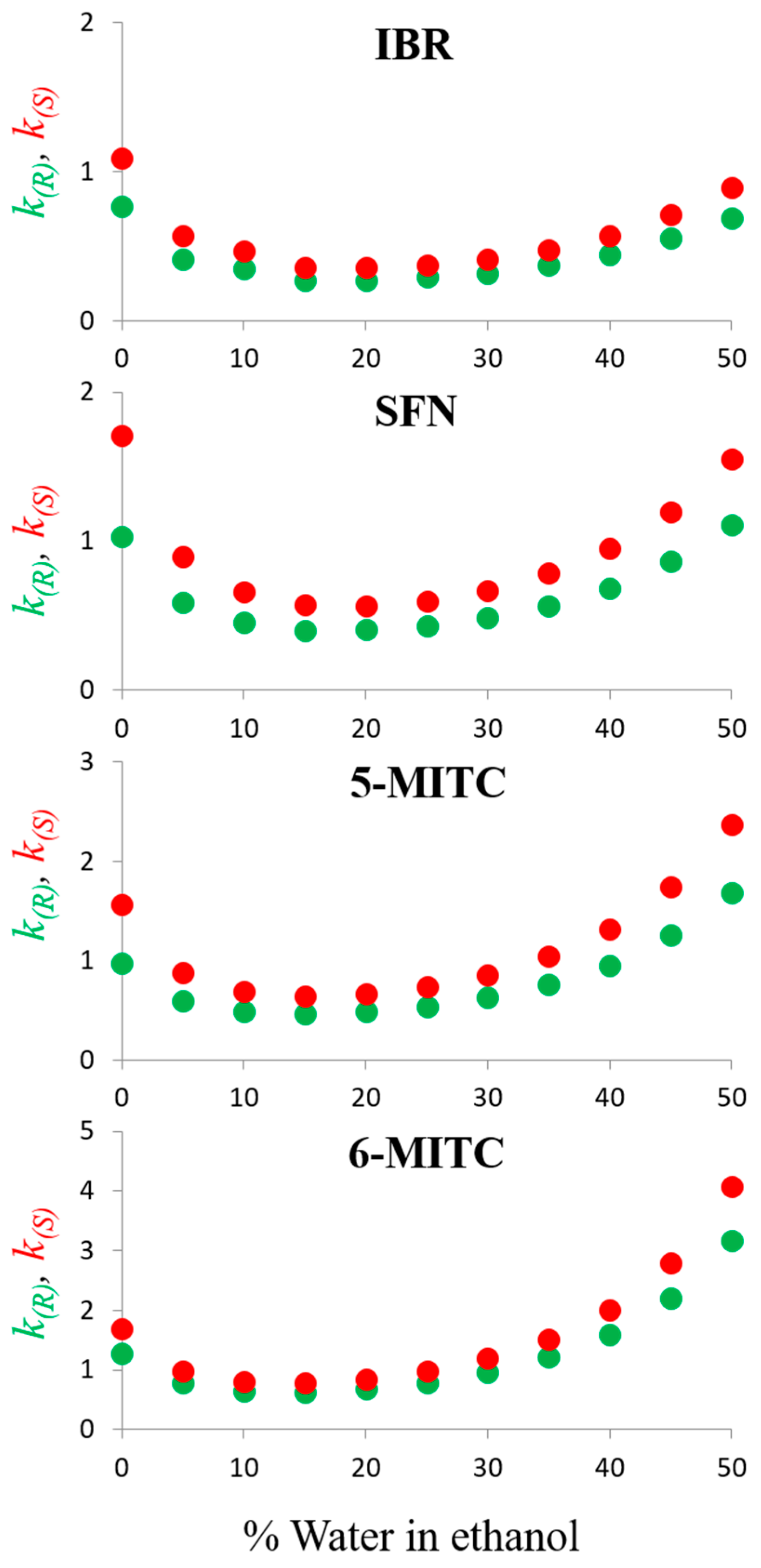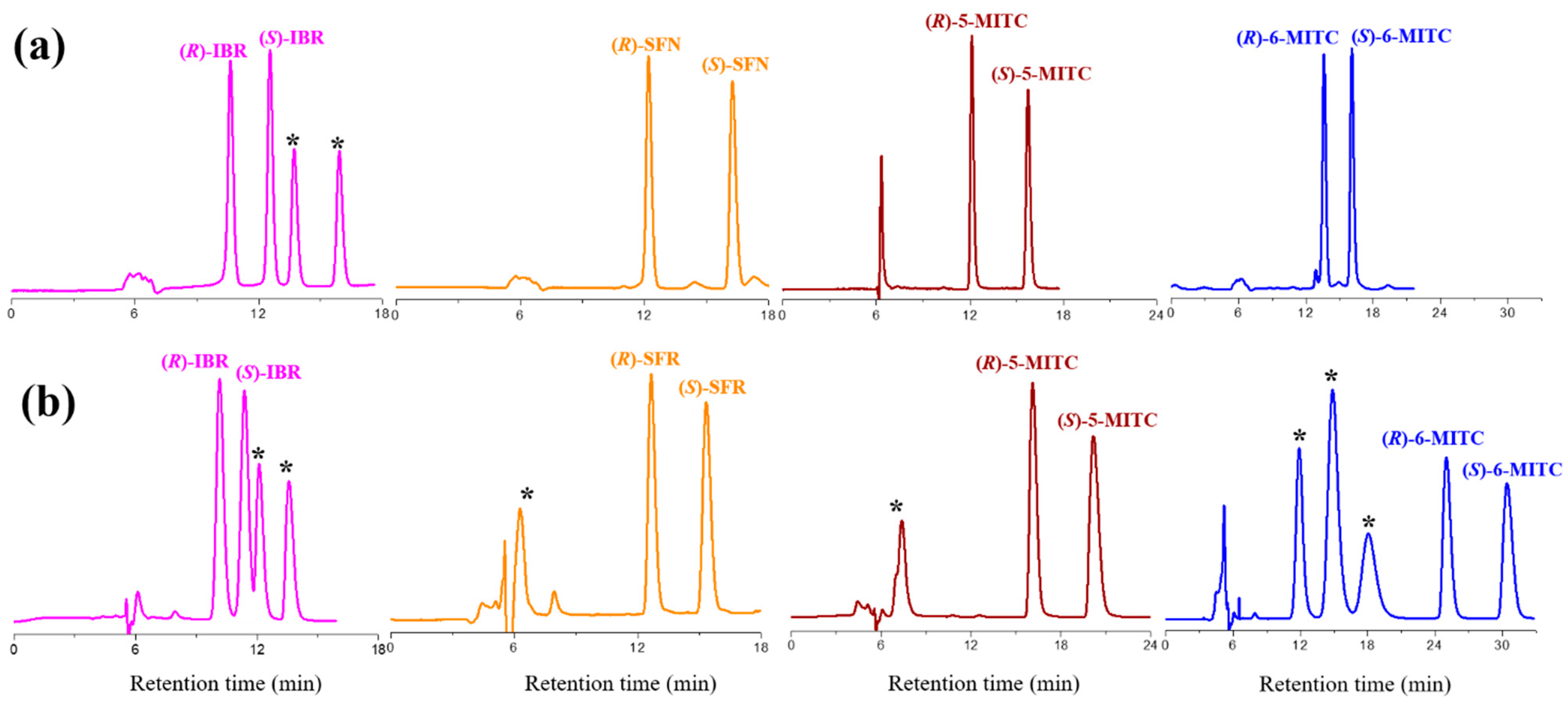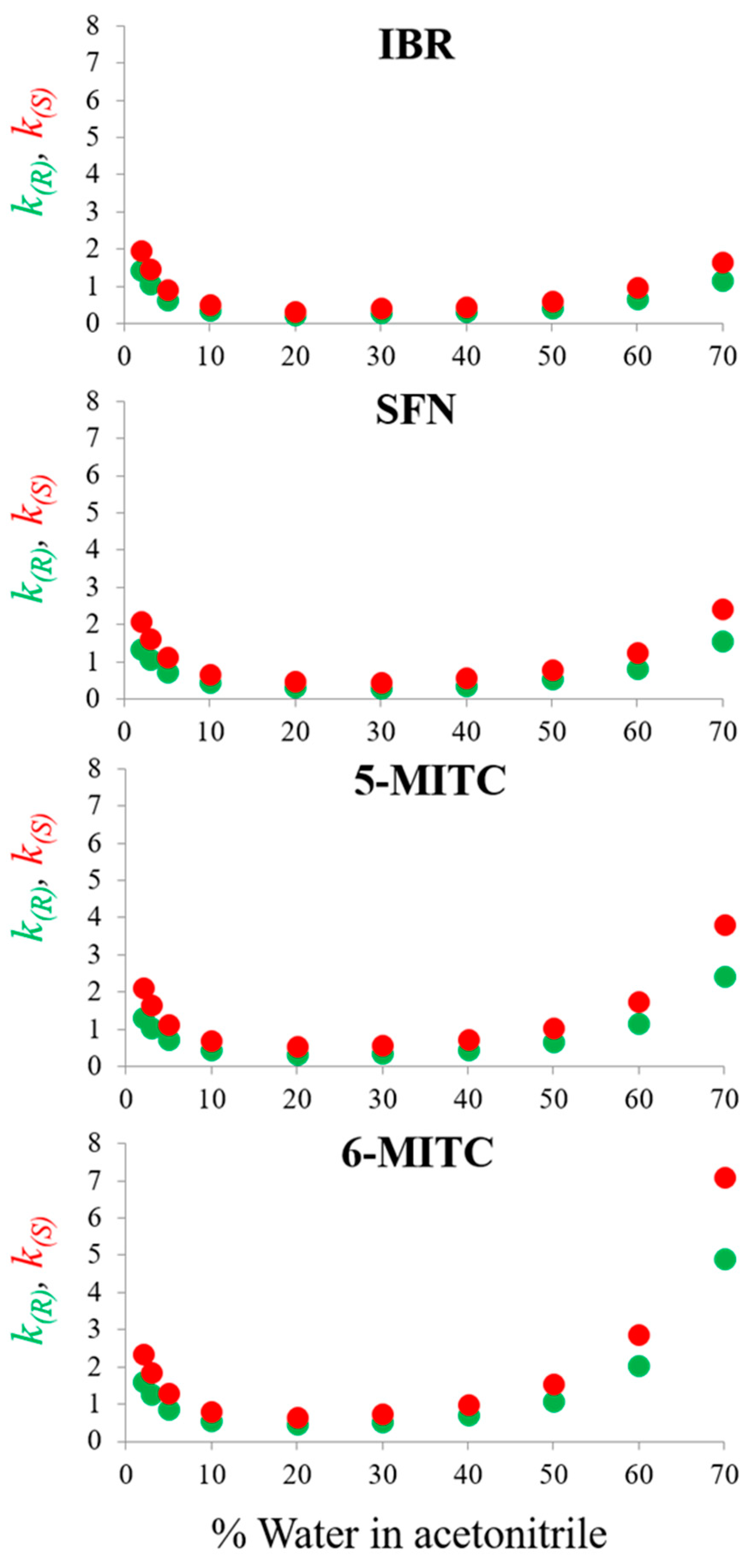Green HPLC Enantioseparation of Chemopreventive Chiral Isothiocyanates Homologs on an Immobilized Chiral Stationary Phase Based on Amylose tris-[(S)-α-Methylbenzylcarbamate]
Abstract
:1. Introduction
2. Results
2.1. Enantioseparations with Ethanol-Based Eluents
2.2. Enantioseparations with Methanol-Based Eluents
2.3. Enantioseparations with Acetonitrile–Water Eluents
3. Materials and Methods
3.1. Materials
3.2. Instruments and Chromatographic Conditions
3.3. Absolute Configuration Assignment
4. Conclusions
Supplementary Materials
Author Contributions
Funding
Institutional Review Board Statement
Informed Consent Statement
Data Availability Statement
Conflicts of Interest
References
- Recio, R.; Vengut-Climent, E.; Borrego, L.G.; Khiar, N.; Fernandez, I. Biologically active isothiocyanates: Protecting plants and healing humans. Stud. Nat. Prod. Chem. 2017, 53, 167–230. [Google Scholar]
- Vanduchova, A.; Anzenbacher, P.; Anzenbacherova, E. Isothiocyanate from broccoli, sulforaphane, and its properties. J. Med. Food. 2019, 22, 121–126. [Google Scholar] [CrossRef] [PubMed]
- Brown, K.K.; Hampton, M.B. Biological targets of isothiocyanates. Biochim. Biophys. Acta 2011, 1810, 888–894. [Google Scholar] [CrossRef] [PubMed]
- Wang, N.; Wang, W.; Liu, C.; Jin, J.; Shao, B.; Shen, L. Inhibition of growth and induction of apoptosis in A549 cells by compounds from oxheart cabbage extract. J. Sci. Food Agric. 2016, 96, 3813–3820. [Google Scholar] [CrossRef] [PubMed]
- Wu, X.; Zhou, Q.H.; Xu, K. Are isothiocyanates potential anti-cancer drugs? Acta Pharmacol. Sin. 2009, 30, 501–512. [Google Scholar] [CrossRef] [PubMed]
- Zhao, H.; Lin, J.; Grossman, H.B.; Hernandez, L.M.; Dinney, C.P.; Wu, X. Dietary isothiocyanates, GSTM1, GSTT1, NAT2 polymorphisms and bladder cancer risk. Int. J. Cancer 2007, 120, 2208–2213. [Google Scholar] [CrossRef] [PubMed]
- Prashar, A.; Siddiqui, F.; Singh, A.K. Synthetic and green vegetable isothiocyanates target red blood leukemia cancers. Fitoterapia 2012, 83, 255–265. [Google Scholar] [CrossRef]
- Mitsiogianni, M.; Koutsidis, G.; Mavroudis, N.; Trafalis, D.T.; Botaitis, S.; Franco, R.; Zoumpourlis, V.; Amery, T.; Galanis, A.; Pappa, A.; et al. The role of isothiocyanates as cancer chemo-preventive, chemo-therapeutic and anti-melanoma agents. Antioxidants 2019, 8, 106. [Google Scholar] [CrossRef]
- Núñez-Iglesias, M.J.; Novío, S.; García, C.; Pérez-Muñuzuri, E.; Soengas, P.; Cartea, E.; Velasco, P.; Freire-Garabal, M. Glucosinolate-degradation products as co-adjuvant therapy on prostate cancer in vitro. Int. J. Mol. Sci. 2019, 20, 4977. [Google Scholar] [CrossRef]
- Mastuo, T.; Miyata, Y.; Yuno, T.; Mukae, Y.; Otsubo, A.; Mitsunari, K.; Ohba, K.; Sakai, H. Molecular mechanisms of the anti-cancer effects of isothiocyanates from Cruciferous vegetables in bladder cancer. Molecules 2020, 25, 575. [Google Scholar] [CrossRef]
- Sailo, B.L.; Liu, L.; Chauhan, S.; Girisa, S.; Hegde, M.; Liang, L.; Alqahtani, M.S.; Abbas, M.; Sethi, G.; Kunnumakkara, A.B. Harnessing sulforaphane potential as a chemosensitizing agent: A comprehensive review. Cancers 2024, 16, 244. [Google Scholar] [CrossRef] [PubMed]
- Abdull Razis, A.F.; Iori, R.; Ioannides, C. The natural chemopreventive phytochemical R-sulforaphane is a far more potent inducer of the carcinogen-detoxifying enzyme systems in rat liver and lung than the S-isomer. Int. J. Cancer 2011, 128, 2775–2782. [Google Scholar] [CrossRef] [PubMed]
- Srovnalova, A.; Vanduchova, A.; Svecarova, M.; Anzenbacherova, E.; Tomankova, V.; Anzenbacher, P.; Dvorak, Z. Effects of sulforaphane and its S- and R-enantiomers on the expression and activities of human drug-metabolizing cytochromes P450. J. Funct. Foods 2015, 14, 487–501. [Google Scholar] [CrossRef]
- Marom, H.; Biedermann, P.U.; Agranat, I. Pyramidal inversion mechanism of simple chiral and achiral sulfoxides: A theoretical study. Chirality 2007, 19, 559–569. [Google Scholar] [CrossRef] [PubMed]
- Panusa, A.; Rosetti, A.; Villani, C.; Cirilli, R. Direct HPLC enantioseparation of chemopreventive chiral isothiocyanates sulforaphane and iberin on immobilized amylose-based chiral stationary phases under normal-phase, polar organic and aqueous conditions. Talanta 2020, 218, 121151. [Google Scholar] [CrossRef] [PubMed]
- Okada, M.; Yamamoto, A.; Aizawa, S.; Taga, A.; Terashima, H.; Kodama, S. HPLC Separation of sulforaphane enantiomers in broccoli and its sprouts by transformation into diastereoisomers using derivatization with (S)-leucine. J. Agric. Food Chem. 2017, 65, 244–250. [Google Scholar] [CrossRef] [PubMed]
- Misiewicz, I.; Skupinska, K.; Kasprzycka-Guttman, T. Differential response of human healthy lymphoblastoid and CCRF-SB leukemia cells to sulforaphane and its two analogues: 2-oxohexyl isothiocyanate and alyssin. Pharmacol. Rep. 2007, 59, 80–87. [Google Scholar] [PubMed]
- Pocasap, P.; Weerapreeyakul, N.; Thumanu, K. Alyssin and iberin in cruciferous vegetables exert anticancer activity in HepG2 by increasing intracellular reactive oxygen species and tubulin depolymerization. Biomol. Ther. 2019, 27, 540–552. [Google Scholar] [CrossRef]
- Milczarek, M.; Mielczarek, L.; Lubelska, K.; Dabrowska, A.; Chilmonczyk, Z.; Matosiuk, D.; Wiktorska, K. In vitro evaluation of sulforaphane and a natural analog as potent inducers of 5-fluorouracil anticancer activity. Molecules 2018, 23, 3040. [Google Scholar] [CrossRef]
- Watanabe, M.; Ohata, M.; Hayakawa, S.; Isemura, M.; Kumazawa, S.; Nakayama, T.; Furugori, M.; Kinae, N. Identification of 6-methylsulfinylhexyl isothiocyanate as an apoptosis-inducing component in wasabi. Phytochemistry 2003, 62, 733–739. [Google Scholar] [CrossRef]
- Chen, Y.J.; Huang, Y.C.; Tsai, T.H.; Liao, H.F. Effect of Wasabi component 6-(methylsulfinyl)hexyl isothiocyanate and derivatives on human pancreatic cancer cells. Evid.-Based Complement. Altern. Med. 2014, 2014, 494739. [Google Scholar] [CrossRef]
- Fuke, Y.; Higashi, N.; Nagata, I.; Sakawi, S.; Nomura, T.; Ryoyama, K. 6-(Methylsulfinyl)hexyl isothiocyanate isolated from Wasabi (Wasabia japonica MATSUM) suppresses tumor progression in an experimental mouse system. Food Sci. Technol. Res. 2003, 9, 148–151. [Google Scholar] [CrossRef]
- Yano, S.; Wu, S.; Sakao, K.; Hou, D.X. Wasabi 6-(methylsulfinyl)hexyl isothiocyanate induces apoptosis in human colorectal cancer cells through p53-independent mitochondrial dysfunction pathway. Biofactors 2018, 44, 361–368. [Google Scholar] [CrossRef] [PubMed]
- Lämmerhofer, M. Chiral recognition by enantioselective liquid chromatography: Mechanisms and modern chiral stationary phases. J. Chromat. A 2010, 1217, 814–856. [Google Scholar] [CrossRef]
- Cavazzini, A.; Pasti, L.; Massi, A.; Marchetti, N.; Dondi, F. Recent applications in chiral high performance liquid chromatography: A review. Anal. Chim. Acta 2011, 706, 205–222. [Google Scholar] [CrossRef] [PubMed]
- Tarafder, A.; Miller, L. Chiral chromatography method screening strategies: Past, present and future. J. Chromat. A 2021, 1638, 461878. [Google Scholar] [CrossRef]
- Chankvetadze, B. Recent trends in preparation, investigation and application of polysaccharide-based chiral stationary phases for separation of enantiomers in high-performance liquid chromatography. Trends Anal. Chem. 2020, 122, 1157092. [Google Scholar] [CrossRef]
- Scriba, G.K.E. Chiral recognition in separation sciences. Part I: Polysaccharide and cyclodextrin selectors. TrAC Trends Anal. Chem. 2019, 120, 115639. [Google Scholar]
- Okamoto, Y.; Kawashima, M.; Hatada, K. Useful chiral packing materials for high-performance liquid chromatographic resolution of enantiomers: Phenylcarbamates of polysaccharides coated on silica gel. J. Am. Chem. Soc. 1984, 106, 5357–5359. [Google Scholar] [CrossRef]
- Ikai, T.; Okamoto, Y. Structure control of polysaccharide derivatives for efficient separation of enantiomers by chromatography. Chem. Rev. 2009, 109, 6077–6101. [Google Scholar] [CrossRef]
- Olives, A.I.; González-Ruiz, V.; Martín, M.A. Sustainable and eco-friendly alternatives for liquid chromatographic analysis. ACS Sustain. Chem. Eng. 2017, 5, 5618–5634. [Google Scholar] [CrossRef]
- Sciascera, L.; Ismail, O.; Ciogli, A.; Kotoni, D.; Cavazzini, A.; Botta, L.; Szczerba, T.; Kocergin, J.; Villani, C.; Gasparrini, F. Expanding the potential of chiral chromatography for high-throughput screening of large compound libraries by means of sub-2μm Whelk-O 1 stationary phase in supercritical fluid conditions. J. Chromatogr. A 2015, 1383, 160–168. [Google Scholar] [CrossRef] [PubMed]
- Capello, C.; Fischer, U.; Hungerbühler, K. What is a green solvent? A comprehensive framework for the environmental assessment of solvents. Green Chem. 2007, 9, 927–934. [Google Scholar] [CrossRef]
- Płotka, J.; Tobiszewski, M.; Sulej, A.M.; Kupska, M.; Górecki, T.; Namieśnik, J. Green chromatography. J. Chromatogr. A 2013, 1307, 1–20. [Google Scholar] [CrossRef] [PubMed]
- Cirilli, R.; Carradori, S.; Casulli, A.; Pierini, M. A chromatographic study on the retention behavior of the amylose tris(3-chloro-5-methylphenylcarbamate) chiral stationary phase under aqueous conditions. J. Sep. Sci. 2018, 41, 4014–4021. [Google Scholar] [CrossRef]
- Ferretti, R.; Zanitti, L.; Casulli, A.; Cirilli, R. Green high-performance liquid chromatography enantioseparation of lansoprazole using a cellulose-based chiral stationary phase under ethanol/water mode. J. Sep. Sci. 2016, 39, 1418–1424. [Google Scholar] [CrossRef] [PubMed]
- Rosetti, A.; Ferretti, R.; Villani, C.; Pierini, M.; Cirilli, R. Simultaneous enantio- and diastereo-selective high-performance liquid chromatography separation of paroxetine on an immobilized amylose-based chiral stationary phase under green reversed-phase conditions. J. Chromatogr. A 2021, 1653, 462406. [Google Scholar] [CrossRef]
- Yue, L.; Yeh, M.; Reilly, J.; Wang, B.; Welch, C.J.; Phan, M. Investigation into the performance and stability of immobilized and coated polysaccharide columns in supercritical fluid chromatography. Chirality 2024, 36, e23626. [Google Scholar] [CrossRef] [PubMed]
- Rosetti, A.; Villani, C.; Pierini, M.; Cirilli, R. Comparison of coated and immobilized chiral stationary phases based on amylose tris-[(S)-α-methylbenzylcarbamate] for the HPLC enantiomer separation of α-lipoic acid and its reduced form. Molecules 2021, 26, 1747. [Google Scholar] [CrossRef]
- Colombo, M.; Ferretti, R.; Zanitti, L.; Cirilli, R. Direct separation of the enantiomers of ramosetron on a chlorinated cellulose-based chiral stationary phase in hydrophilic interaction liquid chromatographymode. J. Sep. Sci. 2020, 43, 2589–2593. [Google Scholar] [CrossRef]
- Papp, L.A.; Hancu, G.; Szabó, Z.I. Simultaneous determination of enantiomeric and organic impurities of vildagliptin on a cellulose tris(3-chloro-4-methylphenylcarbamate) column under revered-phase conditions. J. Pharm. Biomed. Anal. 2023, 234, 115495. [Google Scholar] [CrossRef] [PubMed]
- Cirilli, R. HPLC Enantioseparations with polysaccharide-based chiral stationary phases in HILIC conditions. Methods Mol. Biol. 2019, 1985, 127–146. [Google Scholar] [PubMed]
- Alpert, A.J. Hydrophilic-interaction chromatography for the separation of peptides, nucleic acids and other polar compounds. J. Chromatogr. A 1990, 499, 177–196. [Google Scholar] [CrossRef]
- Guarducci, M.A.; Fochetti, A.; Ciogli, A.; Mazzoccanti, G. A Compendium of the principal stationary phases used in Hydrophilic Interaction Chromatography: Where have we arrived? Separations 2023, 10, 22. [Google Scholar] [CrossRef]
- Díaz Merino, M.E.; Lancioni, C.; Padró, J.M.; Castells, C.B. Study of enantioseparation of β-blockers using amylose tris (3-chloro-5-methylphenylcarbamate) as chiral stationary phase under polar-organic, reversed-phase and hydrophilic interaction liquid chromatography conditions. J. Chromatogr. A 2020, 1634, 461685. [Google Scholar] [CrossRef] [PubMed]
- Tanács, D.; Orosz, T.; Ilisz, I.; Péter, A.; Lindner, W. Unexpected effects of mobile phase solvents and additives on retention and resolution of N-acyl-D,L-leucine applying Cinchonane -based chiral ion exchangers. J. Chromatogr. A 2021, 1648, 462212. [Google Scholar] [CrossRef]
- Pereira, A.S.; David, F.; Vanhoenacker, G.; Sandra, P. The acetonitrile shortage: Is reversed HILIC with water an alternative for the analysis of highly polar ionizable solutes? J. Sep. Sci. 2009, 32, 2001–2007. [Google Scholar] [CrossRef]
- Ibrahim, F.A.; Elmansi, H.; Fathy, M.E. Green RP-HPLC method for simultaneous determination of moxifloxacin combinations: Investigation of the greenness for the proposed method. Microchem. J. 2019, 148, 151–161. [Google Scholar] [CrossRef]
- De Nicola, G.R.; Rollin, P.; Mazzon, E.; Iori, R. Novel gram-scale production of enantiopure R-sulforaphane from Tuscan black kale seeds. Molecules 2014, 19, 6975–6986. [Google Scholar] [CrossRef]
- Elhalem, E.; Recio, R.; Werner, S.; Lieder, F.; Calderón-Montaño, J.M.; López-Lázaro, M.; Fernández, I.; Khiar, N. Sulforaphane homologues: Enantiodivergent synthesis of both enantiomers, activation of the Nrf2 transcription factor and selective cytotoxic activity. Eur. J. Med. Chem. 2014, 87, 552–563. [Google Scholar] [CrossRef]





| Entry | Compound | Mobile Phase | k1 | α | Rs |
|---|---|---|---|---|---|
| 1 | IBR | Ethanol | 0.73 | 1.43 | 3.65 |
| 2 | n-Hexane/Ethanol 60:40 | 2.78 | 1.23 | 3.31 | |
| 3 | SFN | Ethanol | 0.98 | 1.66 | 6.49 |
| 4 | n-Hexane/Ethanol 60:40 | 3.32 | 1.57 | 8.85 | |
| 5 | 5-MITC | Ethanol | 0.93 | 1.61 | 5.03 |
| 6 | n-Hexane/Ethanol 60:40 | 2.97 | 1.64 | 8.75 | |
| 7 | 6-MITC | Ethanol | 1.22 | 1.32 | 3.43 |
| 8 | n-Hexane/Ethanol 60:40 | 3.58 | 1.36 | 6.27 |
Disclaimer/Publisher’s Note: The statements, opinions and data contained in all publications are solely those of the individual author(s) and contributor(s) and not of MDPI and/or the editor(s). MDPI and/or the editor(s) disclaim responsibility for any injury to people or property resulting from any ideas, methods, instructions or products referred to in the content. |
© 2024 by the authors. Licensee MDPI, Basel, Switzerland. This article is an open access article distributed under the terms and conditions of the Creative Commons Attribution (CC BY) license (https://creativecommons.org/licenses/by/4.0/).
Share and Cite
Mammone, F.R.; Panusa, A.; Risoluti, R.; Cirilli, R. Green HPLC Enantioseparation of Chemopreventive Chiral Isothiocyanates Homologs on an Immobilized Chiral Stationary Phase Based on Amylose tris-[(S)-α-Methylbenzylcarbamate]. Molecules 2024, 29, 2895. https://doi.org/10.3390/molecules29122895
Mammone FR, Panusa A, Risoluti R, Cirilli R. Green HPLC Enantioseparation of Chemopreventive Chiral Isothiocyanates Homologs on an Immobilized Chiral Stationary Phase Based on Amylose tris-[(S)-α-Methylbenzylcarbamate]. Molecules. 2024; 29(12):2895. https://doi.org/10.3390/molecules29122895
Chicago/Turabian StyleMammone, Francesca Romana, Alessia Panusa, Roberta Risoluti, and Roberto Cirilli. 2024. "Green HPLC Enantioseparation of Chemopreventive Chiral Isothiocyanates Homologs on an Immobilized Chiral Stationary Phase Based on Amylose tris-[(S)-α-Methylbenzylcarbamate]" Molecules 29, no. 12: 2895. https://doi.org/10.3390/molecules29122895






